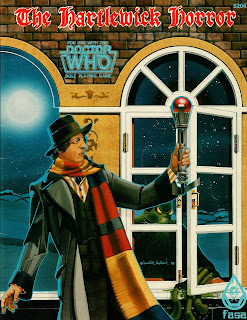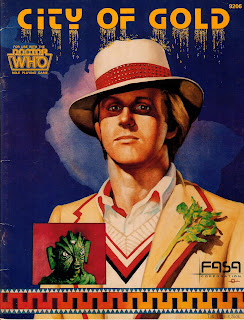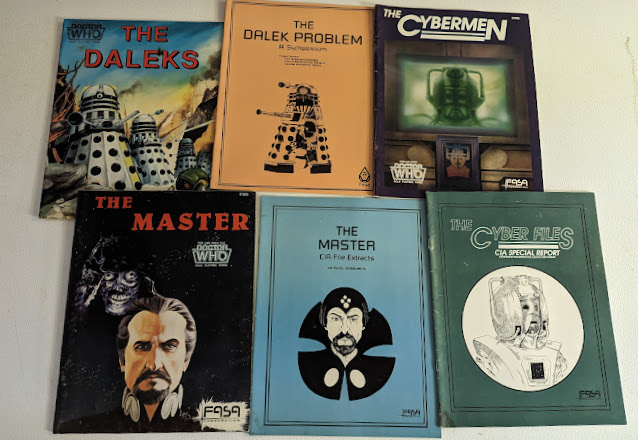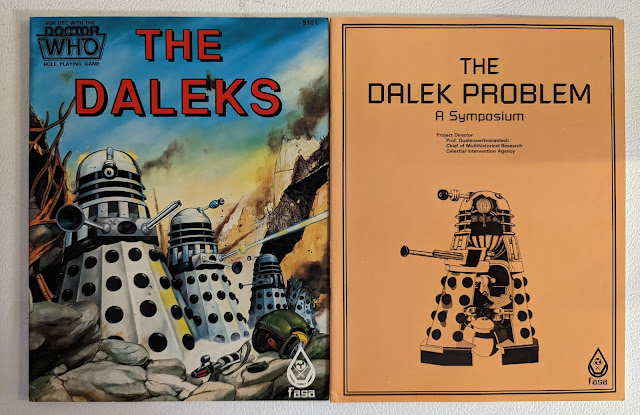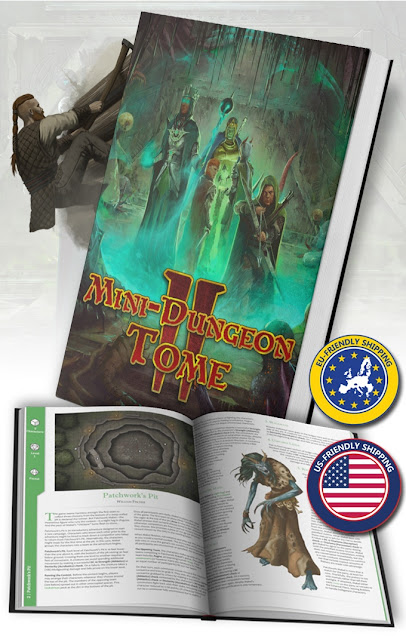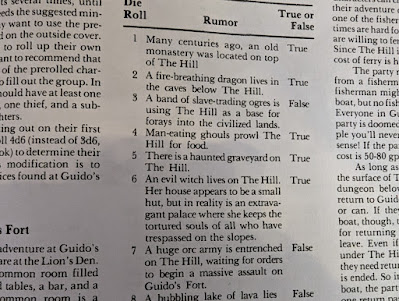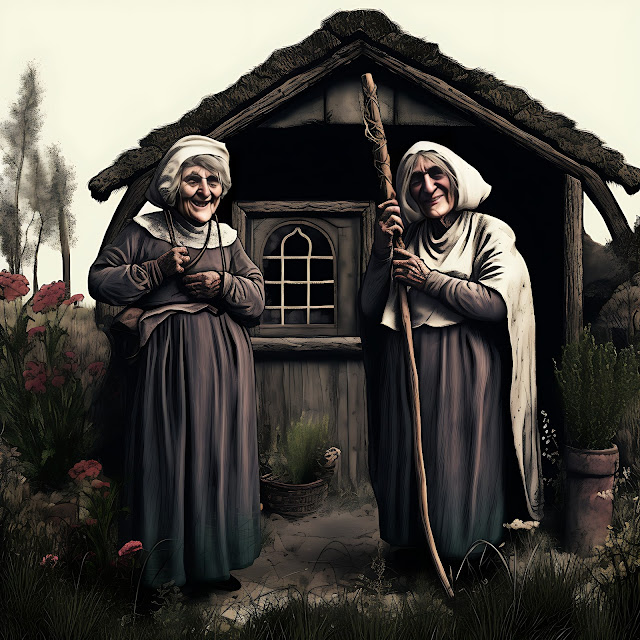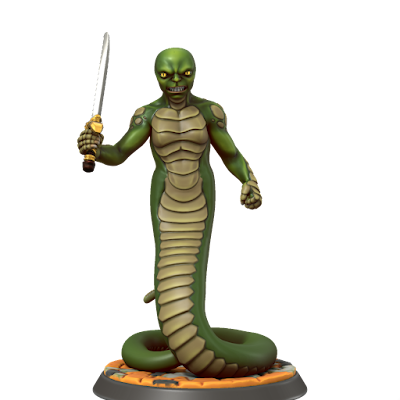
One area where classic Swords & Sorcery fantasy intersects with sci-fi and modern cryptid tales is that of
Snakefolk and
Lizardfolk. My desire to use these creatures as foes date back to Doctor Who's Silurians, Sea Devils, and Draconians, but also before that with the Sleestaks of Land of the Lost. They are great foes and can be quite literally cold-blooded.
Against threats like these, even an orc has more in common with humans.
In my games, both fantasy and sci-fi, the Snakefolk and the Lizardfolk have an alliance in their ultimate goal of killing most of the mammals except what they need for food and slave labor. Of the two, the Snakefolk are more cunning and often (very often) more evil.
I have talked about both of these groups before, and I'll place the links below. Today I wanted to get some stats up for the Snakefolk.
Snakefolk aka Ophidans
Snakefolk, snakemen, serpent people, or ophidians have a long-established history in fantasy, sci-fi and horror. They are a good fit for what I want to do. There are even a lot of snake cults if I wanted to tie in some witchcraft ideas. Not to mention all the monsters associated with snakes like the gorgons, basilisk, hydra, and even the Great Serpent himself (I could go on here, but you get the point).
Ophidians in D&D
Snake folk are such a huge feature in many of the works of the various "Appendix N" authors that one would expect to have seen more with them. Granted there are lots of adventures, especially later one, that feature the Yuan-ti. Maybe it is because they are always featured as a species in decline. This also works for me.
Trouble is Yuan-ti are set as Product Identity and therefore not part of the various OGL SRDs out there. But there are alternates.
Swords & Wizardry featured Ophidians in their Monstrosities book. Pathfinder has their own Ophiduans as well. Both pull from similar sources, namely Lion's Den Press: The Iconic Bestiary -- Classics of Fantasy. These are "updated" to 5e and are found in Frog God's Tome of Horrors for 5e. There is also the related Inphidians for Pathfinder.
I do want to point out that both the Ophidian and the Yuan-ti both premiered in the AD&D 1st Ed Monster Manual II. They don't even look that different from each other, and their descriptions are also very similar.


One became popular (Yuan-ti), and the other was forgotten (Ophidian) when the SRD was released. Did we merge these into one creature back then? I can't recall, but that sounds like something I would do.
Here is what I have in B/X format.
Ophidian
Ophidians are ancient people dating back to a time when humans were little more than savages living in caves. They claim descent from the time when giant reptiles roamed the land and only reptile life was to be seen. This is not entirely true since ophidians are, in truth, the descendants of an ancient group of human snake cultists. Through dark and twisted magics long forgotten, they have become more and more snake-like. The mage-priests of this cult were wiped out by the noble caste who knew of their history and now only the emissary caste remains and they are closely watched by the nobles.
All ophidians appear as snake-like humanoids. The noble and lesser castes have human upper torsos and the lower bodies of giant snakes. The nobles have human-like heads, while the lesser have snake-like ones. The Emissary caste (the descendants of the ancient mage-priests) look nearly human save for some snake-like features. On the opposite ends of the spectrum are the monstrous abominations and the nearly human-looking progenitors. All ophidians are denizens of hot climates, deserts, and jungles, often found in forgotten cities or temples from when their race held greater sway in the world. Ophidians can speak with snakes at will, as per the speak with animals spell.
All ophidians are immune to the bite of other ophidians and other snake-like creatures. Ophidian emissaries also have a potent charm ability. Anytime they use charm magic, they confer a -1 penalty to whomever they are trying to charm. Conversely, all ophidians are subject to the same charm magic saving at -1 on any charm attempt by a foe. This includes other ophidians (for a -2 total).
Breeding and childbirth is tightly controlled by the nobles. All eggs produced and fertilized are kept in hatcheries controlled by the nobles and specially trained emissaries. Criminals, human slaves, the old, and the infirm are tossed into these pits to become food for the next generation of ophidians.
Regardless of how the ophidians see each other castes, they always view humanoid mammals, especially humans, as inferior. Squabbling noble houses will put aside all differences if they are attacked by humans or other humanoids. For example, the Ophidian wars with the Derro are numerous and go back for a thousand years.
Although largely humanoid in form, the ophidians still have the mentality of reptiles. Concepts such as mercy and compromise are unknown to them. They are utterly ruthless and have little concept of honor. Survival and victory are their only goals, though they can employ subtle or deceptive methods to obtain them.
Ophidian, Lesser*
Armor Class: 4
Hit Dice: 3+1 (20)
Move: 120 (40)
Swimming: 120 (40)
Attacks: 2 weapons or bite
Damage: By weapon (1d6) or 1d6 + poison
Special: Poison Bite
No. Appearing: 1d10 (2d100)
Morale: 8
Treasure Type: None
Alignment: Chaotic (Chaotic Evil)
XP: 75
The Lesser Ophidian are the rank and file of Ophidian society. Lesser only reflects its status in the ophidian hierarchy and caste. They are the workers, warriors, and slaves of the Ohidian nobles.
Lesser ophidians appear as large snakes with the muscular upper torso of a human. There are no human secondary sex characteristics among these creatures since they are reptiles. A male lesser ophidian typically has a thicker tail than a female. The males are sterile, and their only function in Ophidian society is to labor and fight. Of the females, at least 50% of these creatures are also born sterile. They are given the same roles as the males. The 50% capable of reproduction are often used as harem slaves or given tasks by the noble caste. Regardless of their caste or station, even the lowest ophidian considers themselves above all humanoids, especially humans, whom they despise.
These ophians can attack with weapons in either or both of their human-like hands. They prefer long curved blades like scimitars and serrated or jagged edges that inflict vicious wounds. Unless directed otherwise, lesser ophidians fight to kill and then eat their prey. They also have fangs in their snake-like heads that have a deadly poison. A bite will cause 1d6 points of damage, and the victim must save vs. poison or dies within 1d4+2 rounds. Neutralize poison magic (spell or potion) will prevent this if given right away. They are immune to the bite of other snakes and snake-like creatures.
Lesser ophidians do not collect treasure in the strictest sense, but they will keep a trophy from a fallen foe. All other spoils by ophidian law belong to the noble caste.
Ophidian, Noble***
Armor Class: 4
Hit Dice: 9+3 (68 hp)
Move: 120 (40)
Swimming: 120 (40)
Attacks: 1 weapon or bite
Damage: By weapon (1d6) or 1d6 + poison
Special: Poison Bite
No. Appearing: 1d4 (2d20)
Morale: 10
Treasure Type: H
Alignment: Chaotic (Chaotic Evil)
XP: 3,000
Ophidian nobles are the ruling caste of the Ophidians, and they do so with an iron fist. They appear as do the lesser ophidians, with humanoid upper bodies with the lower body of a large snake. Their heads, though are more humanoid in appearance. Though their heads are covered in fine scales, and their eyes are slitted like a snake, so they are never mistaken for humans. Similar to the lesser ophidians, only 10% of these creatures are fertile, either male or female, with the fertile ones standing above the infertile. Births among nobles then are rare.
These creatures can also fight with a weapon and prefer the same sorts as their lesser brethren. They typically only fight with one weapon when they have too, but mostly they have 2d8 bodyguards of lesser ophidians to do their fighting for them.
Like all ophidians, they are immune to the venom of other snakes and snake-like creatures. These nobles are also immune to the petrification attacks of medusae and basilisks.
Ophidians delight in cruelty, and none more so than the nobles. The only art they create, if it can even be called that, are ways to torture and kill their enemies.
Ophidian, Emissary**
Armor Class: 6
Hit Dice: 6+2 (39 hp)
Move: 120 (40)
Swimming: 120 (40)
Attacks: 1 weapon or spell
Damage: By weapon (1d6) or spell
Special: Spells (Illusionist magic)
No. Appearing: 1d6 (1d10)
Morale: 10
Treasure Type: O
Alignment: Chaotic (Chaotic Evil)
XP: 950
Ophidian Emissaries are the most human-like of all the known ophidians but never say that to their faces. They appear as normal, if quite thin, humans with some snake-like features. Their tongues are slightly forked, their skin is covered in very fine scales, and their eyes are slits like a snake. They even go as far as displaying secondary sex characteristics of humans, though they are not mammals and do not nurse or even care for their young. Ophidian emissaries, as the name suggests, are often the means which ophidians interact with the world of mammals and humans. They are, however, entirely subjugated by the noble class.
Ophidian emissaries can attack with weapons, but they rarely do. They all have a natural ability for illusion magic and can cast spells as a 5th-level illusionist (magic-user). Their charm ability is superior, and any Charm spell used by an emissary is at a -1 penalty for saving throws.
Unlike their brethren the lesser ophidian class, emissaries chafe under their domination by the noble caste. However, the nobles control every aspect of their lives right down to their breeding. Nearly 90% of all emissaries are fertile, but they are only allowed to breed with nobles, never other emissaries. Emissaries discovered in unsanctioned breeding and reproduction will have their eggs or young destroyed (often eaten). The worst offenders will even be subjected to the horrible eldritch right of Abomination, where they are transformed into a mindless ophidian abomination.
Ophidian, Abomination**
Armor Class: 3
Hit Dice: 10+2 (65 hp)
Move: 120 (40)
Attacks: 2 slams, bite + poison
Damage: 1d6+3 x2, 1d6+3 + poison
Special: Poison Bite
No. Appearing: 1d4 (1d8)
Morale: 12
Treasure Type: None
Alignment: Chaotic (Chaotic Evil)
XP: 2,300
The ophidian abomination is a monster in the truest sense of the word. Large muscular torso springs from a snake-like lower body that can be one, two, or more snake-like tails. some have arms ending in viscous claws, and others have long snakes for arms, complete with snake heads and mouths filled with fangs. No two abominations are alike. Abomination only knows anger and hate for all living things. Their fear and hatred of the noble caste is all that keeps them in check.
Amboniations attack with their claws or fists (slashing or slamming, respectively). Those with human hands can use weapons, but all prefer to attack bare-handed. Their bite is poisonous, save vs. poison or die in 1d4+1 rounds. Abominations with more than one tail, or snakes for arms can also constrict like a large python. These creatures attack without provocation and save their greatest hate for humans. Once engaged they will keep attacking until all foes are dead or they are. For this reason, the nobles use them as front-line troops and shock troops. They are ill-suited for bodyguard work.
Abominations come about in two distinct ways. The first, and the most common, is via birth. The offspring of a noble ophidian and a lesser ophidian has a 1 in 10 (10%) chance of being an abomination. The offspring of a noble with a noble has a 1 in 5 (20%) chance, and between a noble and an emissary a 1 in 20 (5%) chance. The chances of an abomination being born between two emissaries are only 1 in 100 (1%). This is one of the main reasons the nobles control the breed of their people so heavily. The other means is via a dark ritual known to the emissaries from the mage-priests of old. This ritual can change any type of ophidian into an abomination. They consider this to be worse than death.
Ophidian, Progenitor***
Armor Class: 7
Hit Dice: 9 (50 hp)
Move: 90 (30)
Attacks: 1 weapon or spell
Damage: By weapon (1d6) or spell
Special: Cleric and wizard magic
No. Appearing: 1 (1)
Morale: 8
Treasure Type: Q, S
Alignment: Chaotic (Lawful Evil)
XP: 3,000
The ophidian progenitor is an extremely rare Ophidian outside the caste system. They have no recognition within Ophidian society, but it is believed that they are the original Ophidian race and the one from which all the others come. Unlike all the other ophidians, these creatures appear to be completely human. The truth is, quite literally, only skin deep. They wear a skin they have created over a body covered in soft, snake-like scales.
The progenitor will rarely attack as they are far more concerned with extending their lives. It is believed that each progenitor is hundreds of years old, and some were even alive when the Ophidian nobles seized control from the mage-priests. The progenitors are all that is left of that caste.
Each Ophidian progenitor can cast spells as a 5th-level magic-user/wizard and as a 4th-level cleric. They are even believed to know the secrets to turn a converted abomination back into their original caste.
Members of the noble caste will kill a progenitor on sight if they can or have them killed. They fear them too much. It is speculated that some emissaries know the locations of a few progenitors. But to conceal the location of a progenitor will also result in death.
--
I'll likely have more of these guys. I have a lot of notes and other ideas.
Links




.png)






